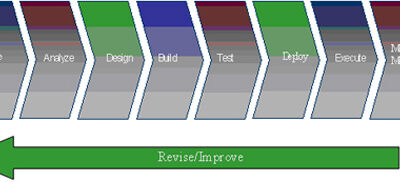The amount of information on the World Wide Web is enormous beyond belief.
Articles by: BPMInstitute.org
BPMS Watch: Process Model Portability: Does Anyone Care?
Among the numerous virtues of BPMN, foremost is vendor independence, giving process modelers many tools to choose from, all describing processes using the same shapes and semantics. That’s huge, since without low-cost (or even free) tools you’ll never establish a culture of process broadly throughout the business. Occasionally, however, a student in my BPMN training will ask the embarrassing question, “So that means I can take the models I create in this class and import them into the BPMN tool we use in our company…
Integrating Testing and Training with the Process Life Cycle
Earlier this year I wrote an article outlining the critical relationship between the Process Life Cycle and the Project Life Cycle. This relationship, when treated as a partnership of equals, can improve the success of both the technical and the process improvement interests. In addition to the Project Life Cycle, there are two other important relationships that should be considered when developing or enhancing a business process.
SOA Watch: SOA and Adapters
Once upon a time, whenever we connected application A to application B, or applications A and B to an integration server, we had to interact with those applications using some sort of interface that (hopefully) the applications provided.
What is a Process?
For years my partners and I at the Performance Design Lab have defined a business process as “a sequence of steps or tasks that produce a valued output”, or words to that effect. Every definition of process I have seen in the books and articles written by others use pretty much the same verbiage. Nothing wrong with the definition – it does describe what a process consists of – but it does nothing to indicate some of the key principles of process design, nor does it do more than hint at why processes are so important (i.e., “valued output”).
So we have come to modify our definition
Questioning Innovation
A dictionary definition of innovation is “introducing something new.” But these days, with the rise of the buzzword “innovation” in the business literature, you’d be led to think that innovation itself is something new. Let’s see if we can net out what’s new about innovation by asking a few questions about this hot business topic.
What’s New About New?
Here we go again with yet another hype curve, the Innovation Hype Curve. Why all the newfound interest in innovation? In short, globalization.
Getting Started is Hard to Do
At this point, the business benefits of business process management seem clear. Virtually every sector of society, including areas that seem relatively impervious to dramatic change, such as higher education and government, are becoming much more outcome-oriented....
BPMS Watch: Step Up Your Modeling Game With Subprocesses
One of the most powerful features of BPMN is the least appreciated… by modelers and tool vendors alike. I’m talking about subprocesses. Most of the process models I have seen would be much improved if they were used more liberally, and more effectively.
In BPMN, a process is viewed as a flow of activities, and an activity – a rectangle in the diagram – can signify only one of two things: a task, meaning it has no subparts of interest to the model, or a subprocess, meaning the activity has subparts of significance to the model.
Defining the Nature and Role of the BPM Professional
As I attend and present at industry BPM conferences, I often survey the participants, asking them to raise their hands if they are from IT departments. Generally, about 30 to 45 percent of the hands go up. I then ask people to raise their hands if they are from the...
Business Process Management – If You Have a Hammer
As a trainer and advocate of standard process languages and standards for metrics I frequently talk to companies that don’t do classic manufacturing; services providers like banks, insurance companies, software companies, etc. Their observation is that they like the value of the standard reference models (SCOR¹, CCOR and DCOR) but they are too manufacturing oriented: “We buy and sell DIY hardware and tools, we don’t make them” and “we provide banking services, we don’t make or ship money”.


















